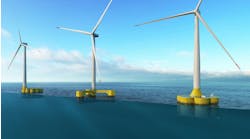First industry-backed method developed for calculating life-cycle carbon footprints
Offshore staff
FREDERICIA, Denmark — Eleven offshore wind developers—bp, EnBW, Fred Olsen Seawind, Parkwind, RWE, ScottishPower Renewables, Shell, SSE, TotalEnergies, Vattenfall and Ørsted—are partnering with the Carbon Trust to make future offshore wind even more sustainable.
The developers design, build and operate offshore wind farms globally, including Europe, North America and Asia. They will work in collaboration with the Carbon Trust as part of the new Offshore Wind Sustainability Joint Industry Programme to develop the first industry-backed methodology and guidance to measure and address the carbon emissions associated with offshore wind farms throughout their life cycle, including emissions from the manufacturing of materials and installation of wind farms.
A common standard will ensure that the scale of installation needed is delivered in a low-carbon way and encourage comparability across developers and assets.
Ingrid Reumert, Ørsted's senior vice president and head of global stakeholder relations, said, “Energy still accounts for 73% of global emissions, which makes a fast transition from fossil fuels to renewables the single most important climate action. As our industry prepares for a massive and necessary buildout of offshore wind farms, we must also pay attention to driving down emissions from supply chains and operations. This common methodology will help us do that as well as increasing transparency for governments, investors and suppliers, and enabling comparability across developers and assets.”
By year-end 2021, 55 GW of offshore wind capacity had been installed globally, with more than one-third being installed within 2021. However, according to the IEA, an additional 70-80 GW will need to be installed every year from 2030 to achieve net-zero emissions by 2050.
Building on the decarbonization efforts at an individual wind farm level, Ørsted said a collaborative industry effort will be key to creating a consistent approach to account for carbon impacts, increase transparency of supply chain emissions and accelerate engagement across the value chain. This will support the delivery of the scale of installation needed, with the benefit of a strong understanding of life-cycle carbon emissions.
While offshore wind energy generation has a lower carbon impact than fossil fuels, Ørsted said the sector must also work collaboratively to decouple its own value chain from carbon and resource-intensive models of production, deployment, and operation, addressing key hot spots such as steel, cement and fuels.
The first project delivered as part of the Offshore Wind Sustainability Joint Industry Programme will:
- Develop the first standardized methodology to enable developers to calculate the life-cycle emissions of their offshore wind assets, including their upstream supply chain emissions, the construction phase and the operation phase;
- Engage with the industry to improve data quality and availability and promote greater supply chain transparency; and
- Identify key carbon emission drivers and hot spots in the offshore wind value chain and wind farm life cycle.
The program officially kicked off in January 2023, with the methodology expected to be released for use across the industry by 2025.
This program is the fifth addition to the Carbon Trust’s renewable energy innovation platform, which consists of a portfolio of R&D activities such as the Offshore Wind Accelerator (OWA), the Floating Wind Joint Industry Programme, the Integrator, and the Offshore Renewables Joint Industry Programme.



